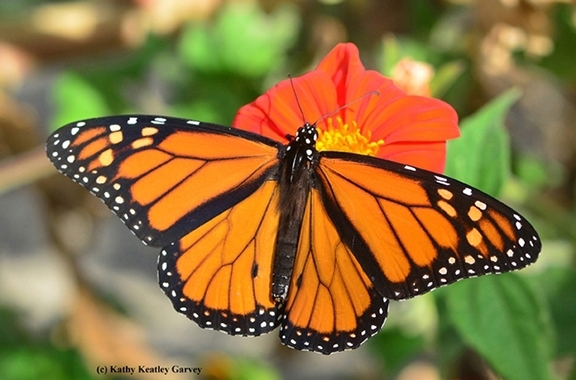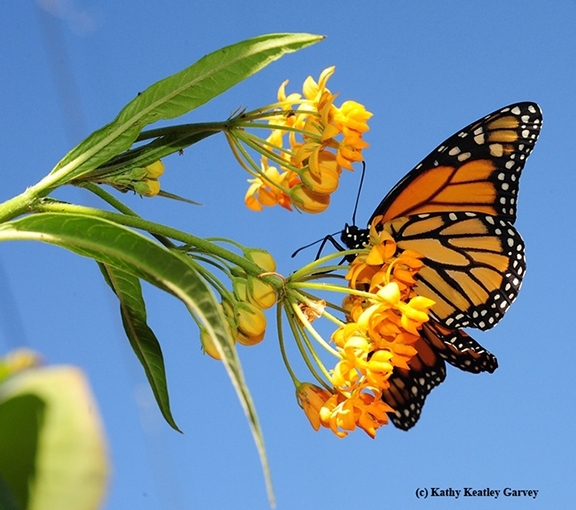
The Xerces Society for Invertebrate Conservation reported this week that its Western Monarch Thanksgiving Count shows a decline for the second consecutive year. “Sadly, fewer than 30,000 monarchs were counted—29,418 to be exact—for the second year in a row, so the western monarch population remains at a critical level,” according to Matthew Shepherd, director of communications and outreach. (See Xerces press release and blog about the population count for this winter.)
Researcher Elizabeth Crone, a professor at Tufts University, Medford, Ma., will shed some light on the issue when she delivers a UC Davis Department of Entomology and Nematology seminar on "Why Are the Monarch Butterflies Declining in the West?" from 4:10 to 5 p.m., Wednesday, Jan. 29 in 122 Briggs Hall, off Kleiber Hall Drive, UC Davis campus. Her longtime collaborator, pollination ecologist and professor Neal Williams, will introduce her.
"Ecologists now face the dual challenge of documenting changes in the environment, and figuring out appropriate strategies for conserving and recovering natural resources in changing environments," says Crone, who is completing a research sabbatical at UC Davis. In her talk, she will focus on “using the tools of population ecology to address both sides of this challenge: quantifying changes in the abundance of western monarch butterflies (and factors associated with these changes), and using theory and data to design strategies and targets for restoration and recovery.”
“Analyses of past dynamics (1980-2017) showed that western monarch butterflies have declined more quickly than their eastern counterparts, and that these declines were most strongly associated with loss of overwintering habitat, and more weakly (but significantly) associated with increased pesticide use and warmer breeding season temperatures,” Crone writes in her abstract. “Analyses of current conditions (2018-2019) suggest that a recent dramatic drop in abundance occurred in spring, between when monarch butterflies leave coastal overwintering sites and arrive in the Central Valley and Sierra Foothills.”
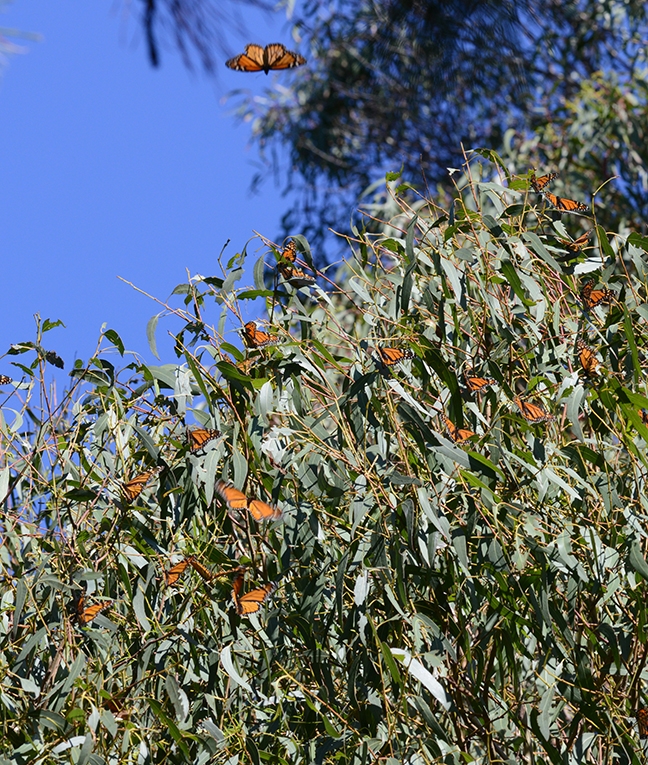
The Xerces Society for Invertebrate Conservation reported this week that its Western Monarch Thanksgiving Count shows a decline for the second consecutive year. “Sadly, fewer than 30,000 monarchs were counted—29,418 to be exact—for the second year in a row, so the western monarch population remains at a critical level,” according to Matthew Shepherd, director of communications and outreach. (See press release and a blog article about the population count for this winter.)
A native of Alexandria, Va., Crone received her bachelor's degree in biology, summa cum laude, from the College of William and Mary, Williamsburg, Va., in 1991, and her doctorate in botany from Duke University in 1995. She served as a postdoctoral researcher at the University of Washington, Seattle, from 1996-1997. Her career encompasses academic appointments at Harvard University, University of Montana, and the University of Calgary.
No stranger to UC Davis, Crone has collaborated with Neal Williams "on and off" for the past 20 years. “We had a National Science Foundation grant to study bumble bee populations from 2014-2019, so I have been visiting regularly since he got here. Starting in winter 2019, I have also had funding to take partial research leave from Tufts and work on western monarchs. I have been about half-time at Tufts and half-time at UC Davis." "I am grateful to Neal and the Entomology Department for hosting me during this extended stay!" she added.
Crone is a co-principal investigator (PI) with PI Cheryl Schultz, associate professor of biological sciences at Washington State University and co-PI Sarina Jepson, endangered species program director, Xerces Society, on a federal grant, "Western Monarch Breeding Phenology" (awarded May 2017-June 2020, with the potential for annual renewal). The grant was funded through the Department of Defense's (DoD) Natural Resources Program, DoD Legacy Program.
Of her research, Crone says "My research focuses on population ecology, especially of plants and insects, and plant-animal interactions. Specifically, I am interested in how environmental changes translate to changes in population dynamics: For example, is there a simple, linear matching of changes in resources to abundance of consumers, or do interactions among individuals and species moderate these responses? Much of my research also involves developing novel quantitative approaches to predict long-term dynamics from small scale observations and experiments. Current projects include studies of butterflies, bees, perennial wildflowers, sugar maples, and acorn-granivore interactions. Past projects include some of the best documented examples of cyclical dynamics in plant populations and spatial metapopulation dynamics in animal populations. I was also one of the first ecologists to adapt generalized linear mixed models to estimate variance terms for stochastic population models."
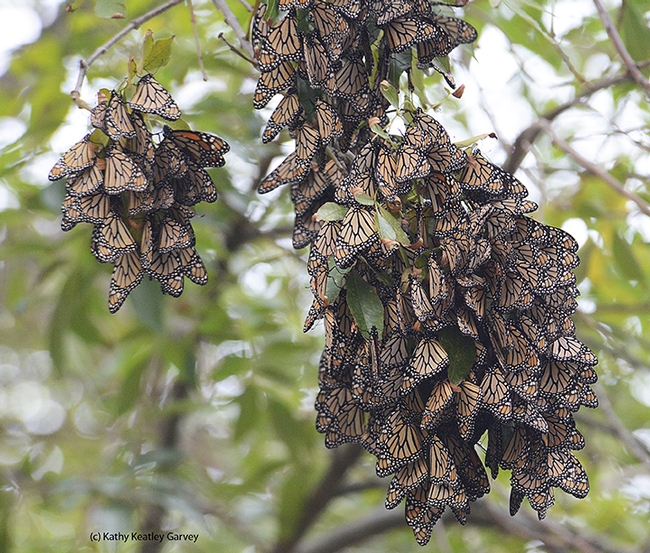
Her honors and awards are many and varied:
- Project of the Year Award, SERDP (Strategic Environmental Research and Development Program) 2018
- Foreign Member, Finnish Academy of Science and Letters (elected 2017)
- Vice Chair / Chair, Theoretical Ecology Section, Ecological Society of America, 2010-2012
- Ecological Research Award, Ecological Society of Japan, 2014
- Fulbright Fellowship, 2007-2008
- National Science Foundation (NSF) Postdoctoral Fellowship in Biosciences Related to the Environment (1996-1997)
- U.S. Department of Energy Graduate Fellowship for Global Change (1991-1995)
- Baldwin Speece Award (College of William and Mary, for scholarship/service in ecology, 1991)
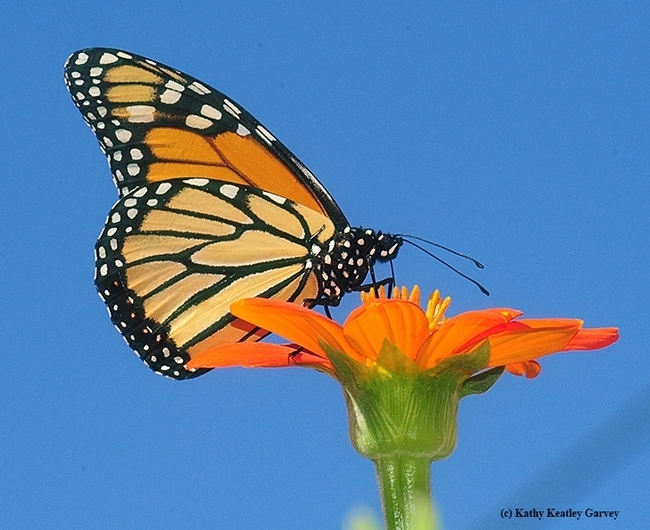
How did you get interested in science? Was there an "ah ha" moment?
I was in an REU (Research Experiences for Undergraduates) program studying plant-insect interactions in 1990. The thing that made me want to go to grad school was the fun puzzle of designing an experiment AND figuring out how to interpret the data - I had collected data on beetle feeding rates, and when I didn't know how to analyze them my advisor said "read a statistics book" ... so I did--since then I have always especially loved the puzzle of matching models to data.
From an earlier age, I have always enjoyed being outdoors, which is probably why I chose to study biology. But that was the moment when I knew I would enjoy a life of research.
Some of your major accomplishments?
From an applied ecology perspective, the biggest is helping the Fender's blue butterfly move from being listed as endangered to nearly ready for down-listing. From a basic ecology perspective, I figured out the ecological interpretation of variance terms in mixed models as estimates of spatial heterogeneity and environmental stochasticity, and worked out one of the best examples of how mast-seeding species are synchronized by their pollinators.
What fascinates you about monarchs?
The possibility that we can recover the western monarch population from its recent steep decline to being abundant again. This should be a problem we can fix.
What do you like best about science?
The puzzle of matching models to data and the possibility of saving species from extinction.
Any scientists in the family?
My sister is an astronomer. My dad was a math professor. Before him, though, no one in the extended family had even gone to college.
What do you do in your leisure time?
I once gut-renovated a house (with help from carpenters, but doing some of the work myself), I am very proud of my urban pollinator garden in Somerville (near Boston, Mass., and I am a good enough trombonist to (just barely) keep up with my trombonist friends.
Future plans?
I am waiting to find out whether our monarch funding will be extended or whether I will go back to a regular teaching schedule at Tufts. Even if I go back to "full-time" teaching, I am sure I will be doing western monarch and bumble bee research for the indefinite future, and will continue to be at least partly bicoastal.
(Editor's Note: the Xerces Society's site-by-site monarch count data is available at https://www.westernmonarchcount.org/data/. This covers all years since the first count in 1997.)
Attached Images:
